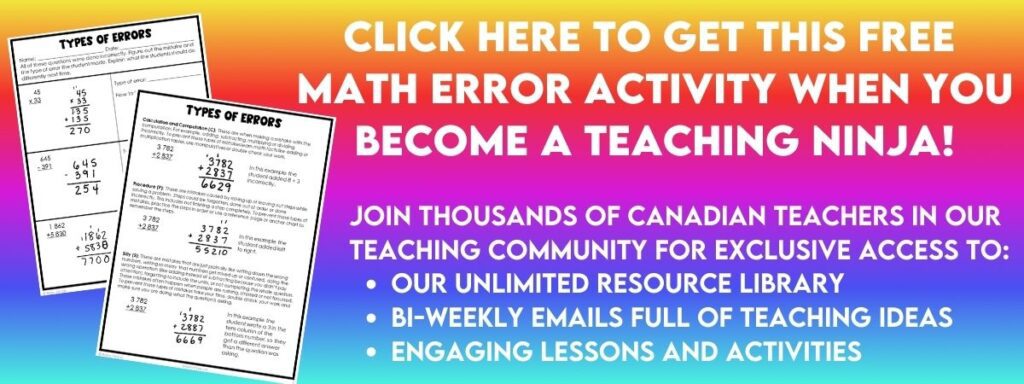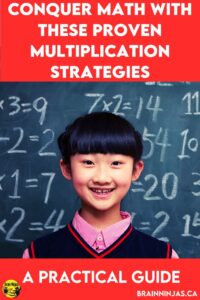
We have taught students in grades four and five for so long and one trend we’ve noticed is that students cannot retain their multiplication times tables. What is happening to those little brains? Or is it because we teach these facts differently? We’ve been thinking about the different multiplication strategies we use in our classroom.
When we went to school, math drills were all the rage. But to be honest, the stress of answering sixty multiplication questions in less than a minute was horrible. And, I was lucky because I knew my times tables, but I just couldn’t write fast enough no matter how hard I tried. Those drills weren’t an assessment of my math skills. They were an assessment of how quickly I could write.
And don’t even get me started about the time I wrote a zero, but it was messy and looked like a six. Ugh! So, I knew I couldn’t give my students math drills. Here’s what we do instead.
Practice, Practice, Practice
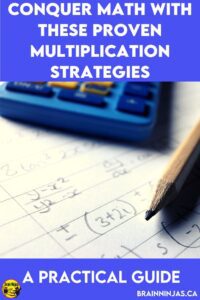
For some reason, we don’t seem to have the memory skills we once had. I can still remember phone numbers from childhood, but I don’t know my own husband’s work number by heart. Why? Is it because of automation? Is it because of a lack of practice? Are our brains just wired differently now?
We’d love to say there is some sort of magic to getting students to remember their multiplication facts, but honestly, the only thing we’ve discovered that works is actually practicing them. It is rote learning and it is not very exciting. Math is exciting, but memorizing times tables is not fun (or math, for that matter). Regardless, they are important to know.
Math Graphing is Where It Is At
We wanted to take the pressure out of math drills but still practice just like a math drill, so we created a Math Fact Fluency Practice set to see what would happen. Each week, our students do a math “drill” where it isn’t timed. Students time themselves by writing down how long it took for them to finish. Our students can also use manipulatives or multiplication charts to help them get the answers. This is very helpful at first, but eventually, students can get the answers without the extra help.
Student mark their drills and then graph their progress on their own chart) that no one else sees. This graph is kept for their eyes only, but since we keep them in their interactive notebooks, we inform students that we look at the graphs to make sure they are completed and that there is improvement happening.
Try Math Facts Fluency Graphing
(5 x 5 = 25) Multiplication & Division Find this set in our TpT Store ($USD) or BN Shop ($CAN).
(7 x 7 = 49) Multiplication & Division Find this set in our TpT Store ($USD) or BN Shop ($CAN).
(9 x 9 = 81) Multiplication & Division Find this set in our TpT Store ($USD) or BN Shop ($CAN).
(10 x 10 = 100) Multiplication & Division Find this set in our TpT Store ($USD) or BN Shop ($CAN).
(12 x 12 = 144) Multiplication & Division Find this set in our TpT Store ($USD) or BN Shop ($CAN).
The bundle with all five sets can be found in our TpT Store ($USD) or BN Shop ($CAN).
Explicitly Teach Multiplication Strategies.
By putting students in charge of their own learning, it’s easier for them to make a goal they can achieve and they are only competing with themselves. We build these graphs right into our Interactive Math Notebooks all year. Want to know how? Read Things We Learned from Interactive Math Notebooks or How to Use Interactive Notebooks to Teach Number Sense.
We outline different multiplication strategies in our Interactive Math Units. Each unit includes templates, lessons and practice worksheets. We’ve even included background information for teachers and photographs of the steps. We’ve written a unit test that you can pick and choose from so you can assess your students. Our math units are aligned to the new Alberta, BC and Saskatchewan curricula.
Number Operations Interactive Math Unit Grade 3. Find it on TpT ($USD) or our BN Shop ($CAN).
Number Operations Interactive Math Unit Grade 4. Find it on TpT ($USD) or our BN Shop ($CAN).
Number Operations Interactive Math Unit Grade 4/5. This is designed for combined classrooms. Find it on TpT ($USD) or our BN Shop ($CAN).
Number Operations Interactive Math Unit Grade 5. Find it on TpT ($USD) or our BN Shop ($CAN).
Number Operations Interactive Math Unit Grade 5/6. This is designed for combined classrooms. Find it on TpT ($USD) or our BN Shop ($CAN).
Number Operations Interactive Math Unit Grade 6. Find it on TpT ($USD) or our BN Shop ($CAN).
Teach students how to use a times tables chart. This simple tool is often overlooked, but not only can it be used for multiplication, but it can also be used for division and equivalent fractions (it’s so valuable!).
Games to Practice Fluency
Around the World
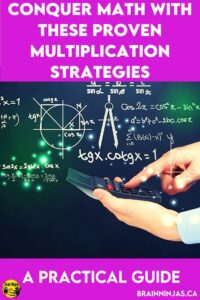
Write out multiplication questions on one side of an index card and the answer on the back. You’ll need several cards. On one card, write “Around the World.”
Students make a circle. Show a card to two students standing side by side. The first student who answers correctly continues and moves to the next student with you. The game continues until the Around the World card shows up. The last student to have answered before the card appeared wins.
Playing Cards
Take a deck of cards and remove any face cards or number cards that are above the level you need. For example, if you only teach Grade 4 and go up to 7 x 7, then remove all the eights and nines as well. Shuffle the remaining cards and deal all of them between two students. They each place one card face up. The first person to correctly multiply the two numbers keeps both cards. The game continues until one player has all the cards.
Entrance or Exit Cards
Use your flashcards to have students answer questions as they enter or exit the classroom.
This website has several games that you can download for free. Some of them are great and easy to use. Multiplication.com
Add Music to Your Routine
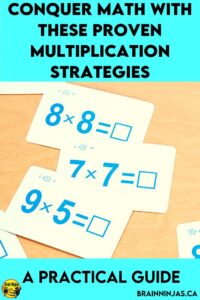
There are so many math songs on YouTube and GoNoodle. If you use Google Chrome, download the AdBlocker Extension to get rid of the ads.
Play Worksheet Games
We’ve collected a whole bunch of different ways you can use worksheets in this post: Math Worksheet Games Your Students Will Love.
If you need a few worksheets that practice multiplication, try these:
These use simple calculations, but students can use any strategy to solve them.
Multiplication and Division to 25 Math Worksheets. Find them on TpT ($USD) or in our BN Shop ($CAN).
Multiplication and Division to 100 Math Worksheets. Find them on TpT ($USD) or in our BN Shop ($CAN).
These equations require long multiplication or division. Students can use any strategy to solve and there is plenty of room to make calculations.
2 Digits by 1 Digit Multiplication Worksheets. Find them on TpT ($USD) or in our BN Shop ($CAN).
Multiply and Divide 2 by 1 Digit Worksheets. Find them on TpT ($USD) or in our BN Shop ($CAN).
3 Digits by 1 Digit Multiplication Worksheets. Find them on TpT ($USD) or in our BN Shop ($CAN).
Multiply and Divide 3 by 1 Digit Worksheets. Find them on TpT ($USD) or in our BN Shop ($CAN).
2 Digits by 2 Digits Multiplication Worksheets. Find them on TpT ($USD) or in our BN Shop ($CAN).
3 Digits by 2 Digit Multiplication Worksheets. Find them on TpT ($USD) or in our BN Shop ($CAN).
If your students are moving beyond simple multiplication of whole numbers you can try these:
Multiplication and Division of Decimals to Hundredths. Find them on TpT ($USD) or in our BN Shop ($CAN).
Multiplication and Division of Decimals to Thousandths. Find them on TpT ($USD) or in our BN Shop ($CAN).
Multiplication and Division of Mixed and Improper Fractions. Find them on TpT ($USD) or in our BN Shop ($CAN).
Ways to Practice at Home
Making Flash Cards
Just the act of making flashcards for practice can help with retaining answers. Send your students home with index cards. They are usually easy to find at dollar stores. We cut ours in half to make them go further.
Quizzing Parents
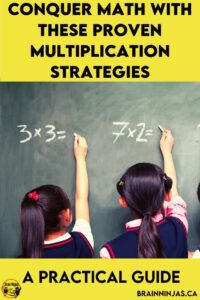
Have your students quiz their parents on their times tables and then check their answers.
Websites
prodigy.com is free and easy to use for math concepts. IXL math has a Canadian version and versions for other countries. If your school is lucky enough to have a subscription to Mathletics, they can use their account at home. We’ve also used TimesTables.com (it has more ads and is a little more clunky, but it works!)
Long Multiplication
If your students don’t know their multiplication facts, they are going to struggle with long multiplication.
We are required to teach students to develop a personal strategy to do long multiplication, which means if the traditional algorithm isn’t working for them, it’s up to teachers to help students find a way that works.
We use this video from Math Antics to help practice the traditional algorithm. His videos are very helpful (better than anything we can make).
Sometimes, students just get stuck. Even worse, parents sometimes insist their child learn how to do something the way they learned it.
The challenge as teachers can be representing information to students in a way they can review and re-watch it. Our solution was to create short videos for our students and we’ve decided to clean them up and share them with you.
Once we taught our students the lattice method, they soared! Not only could they achieve grade level, but they challenged themselves to multiply larger and larger numbers (it became their “fun” time activity).
The first video shows lattice multiplication of two digits by one digit (24 x 8 ) and three digits by one digit (274 x 9). Give your students a whiteboard or paper to write the equations and follow along.
The second video shows lattice multiplication of two digits by two digits (27×84).
In our experience, this strategy is a preferred method for many of our students. That is not to say we didn’t teach our students other methods if they needed it. Most of our students don’t struggle with the process of lattice multiplication. They struggle with knowing their multiplication facts.
Looking for Errors
One way we check for understanding is to intentionally do equations incorrectly and then see if our students can find the mistakes. You can find our Error Analysis Activity in the Resource Library. Or, we can send it directly to your inbox when you join thousands of Canadian teachers on our email list.
Teaching Elementary Math?
You might find these posts helpful:
- The Truth About New Math
- How to Change Math With Interactive Notebooks
- The Trouble With Task Cards and How to Fix It
- Math Worksheet Games Your Students Will Love
- How to Use Interactive Notebooks to Teach Number Sense
- Mastering the Angles: Innovative Approaches to Teaching Geometry Concepts
- How to Teach Students to Analyze Errors in Math
- How to Help Your Students Master Decimal Operations
- Ways to Bring Graphing Activities into Your Classroom Daily
- How to Add Candy to Your Math Lessons
- How to Teach Successful Long Division Strategies
- How to Make Teaching Patterns Painless
- Ways to Teach Classifying Triangles
- How to Teach Rounding Numbers
If you are looking for a specific strategy, let us know in the comments below. If you use these videos, let us know what your students think. Did they help? What tricks do you have for teaching your students their multiplication facts?

